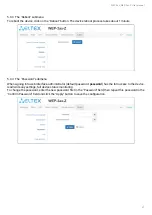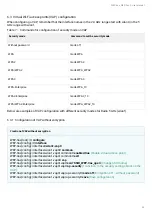
WEP-3ax, WEP-3ax-Z. User manual
61
802.11r configuration on AP2
WEP-3ax(config):/interface/wlan1-vap0/vap/ft-config#
enabled false
WEP-3ax(config):/interface/wlan1-vap0/vap/ft-config#
r1-key-holder-id 02:03:04:05:06:08
(VAP MAC
address. DIsplayed in the
ifconfig
command output)
WEP-3ax(config):/interface/wlan1-vap0/vap/ft-config#
r0-key-holder-id 23456
(Unique key for the given
VAP)
WEP-3ax(config):/interface/wlan1-vap0/vap/ft-config#
mobility-domain 100
(The domain should be
same on the counter VAP)
WEP-3ax(config):/interface/wlan1-vap0/vap/ft-config#
mac
WEP-3ax(config):/interface/wlan1-vap0/vap/ft-config/mac#
add
E8:28:C1:FC:D6:80
(MAC address of the
ounter access point - AP1)
WEP-3ax(config):/interface/wlan1-vap0/vap/ft-config/mac#
exit
WEP-3ax(config):/interface/wlan1-vap0/vap/ft-config#
mac
WEP-3ax(config):/interface/wlan1-vap0/vap/ft-config/mac#
E8:28:C1:FC:D6:80
WEP-3ax(config):/interface/wlan1-vap0/vap/ft-config/mac/E8:28:C1:FC:D6:80#
r0-kh-id 12345
(Unique
key for the counter VAP of the AP1 access point)
WEP-3ax(config):/interface/wlan1-vap0/vap/ft-config/mac/E8:28:C1:FC:D6:80#
r1-kh-id
02:03:04:05:06:07
(MAC address of the counter VAP of AP1)
WEP-3ax(config):/interface/wlan1-vap0/vap/ft-config/mac/E8:28:C1:FC:D6:80#
r0-kh-key
0001020304050607
(Random key. Should not coincide with r1-kh-key of AP2, but should coincide with r1-
kh-key of the counter AP1)
WEP-3ax(config):/interface/wlan1-vap0/vap/ft-config/mac/E8:28:C1:FC:D6:80#
r1-kh-key
0102030405060708
(Random key. Should not coincide with r0-kh-key of AP2, but should coincide with r0-
kh-key of the counter AP1)
WEP-3ax(config):/interface/wlan1-vap0/vap/ft-config/mac/E8:28:C1:FC:D6:80#
exit
WEP-3ax(config):/interface/wlan1-vap0/vap/ft-config/mac#
exit
WEP-3ax(config):/interface/wlan1-vap0/vap/ft-config#
enabled true
(Enable access point operation using
the 802.11r protocol)
WEP-3ax(config):/interface/wlan1-vap0/vap/ft-config#
save
(Save configuration)
802.11k configuration
802.11k roaming can be organized between any networks (open/encrypted). If the access point is configured
to work with the 802.11k protocol, then, when the client connects, the access point sends him a list of
"friendly" access points to which the client can switch while roaming. The list contains information about the
MAC addresses of access points and the channels on which they operate.
Using 802.11k reduces the time it takes the client to find another network when roaming because the client
does not have to scan for channels where there are no target access points available for switching.
This type of roaming is only available for client devices that support 802.11k.
Below is an example of how to configure 802.11k on an access point – making a list of "friendly" access
points.
















































